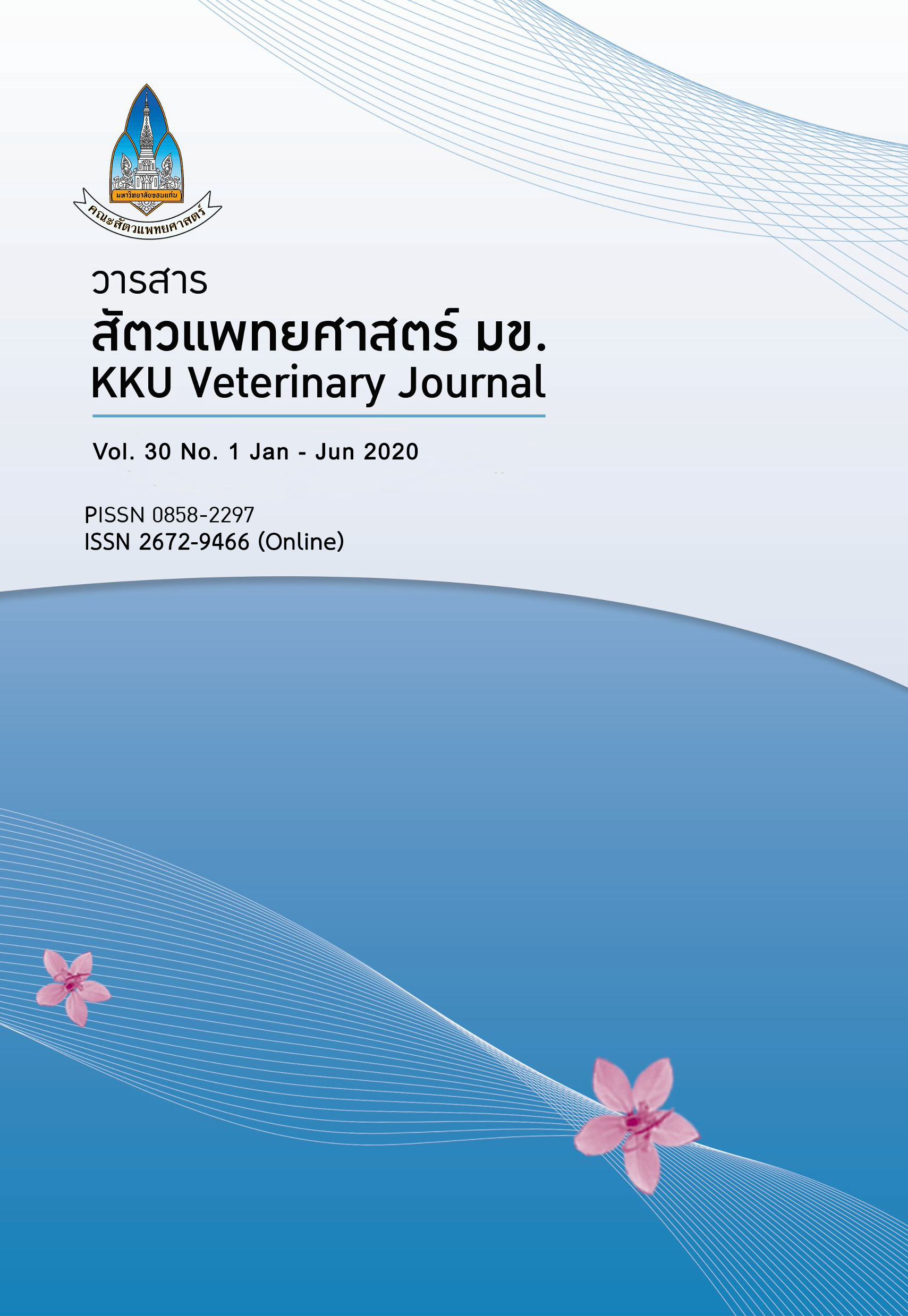ความชุกและการดื้อยาต่อยาต้านจุลชีพของเชื้อซัลโมเนลลาที่แยกได้จากสุนัขในจังหวัดขอนแก่น
Main Article Content
บทคัดย่อ
วัตถุประสงค์ เพื่อหาความชุก ซีโรวาร์ ของเชื้อซัลโมเนลลาที่แยกได้จากสุนัขในจังหวัดขอนแก่น และทดสอบการดื้อยาของเชื้อดังกล่าวต่อยาต้านจุลชีพ 7 ชนิด
วัสดุ อุปกรณ์ และวิธีการ เก็บตัวอย่างอุจจาระจากสุนัขที่มารับการรักษาในคลีนิกรักษาสัตว์ ด้วยวิธี rectal swab จำนวน 428 ตัวอย่าง ระหว่างเดือนมกราคม พ.ศ. 2556 – ธันวาคม พ.ศ.2558 ทำการตรวจแยกและวินิจฉัยเชื้อซัลโมเนลลาด้วย วิธี ISO 6579:2002 จากนั้นทดสอบการดื้อของเชื้อซัลโมเนลลาต่อยาต้านจุลชีพ 7 ชนิด ด้วยวิธี disk diffusion test ได้แก่ chloramphenicol, norfloxacin, ciprofloxacin, gentamicin, sulfamethoxazole-trimethoprim and tetracycline.
ผลการศึกษา พบความชุกของเชื้อซัลโมเนลลาทั้งในสุนัขที่มีและไม่มีอาการท้องร่วง11.92%(51/428) จำแนกได้ 22 ซีโรวาร์ โดยซีโรวาร์ที่พบมากที่สุดได้แก่ S. Typhimurium (19.60%) S. Weltevreden (15.69%) และ S. Give (9.80%) ตามลำดับ เชื้อที่แยกได้มีอัตราการดื้อต่อยาต้านจุลชีพ เรียงลำดับจากมากไปน้อยดังนี้ tetracycline (78.4%), amoxicillin (51.0%), nalidixic acid (27.5%), sulfamethoxazole-trimethoprim (23.5%), gentamicin (7.8%), norfloxacin (5.9%), และ ciprofloxacin (5.9 %)
ข้อสรุป การศึกษานี้พบว่า เชื้อซัลโมเนลลาสามารถแยกได้จากสุนัขทั้งในสุนัขปกติที่มีและไม่มีอาการท้องร่วง บางซีโรวาร์ที่พบเป็นชนิดเดียวกับซีโรวาร์ที่ก่อโรคในมนุษย์ นอกจากนี้ ยังพบว่าเชื้อที่แยกได้มีสัดส่วนการดื้อต่อยาต้านจุลชีพหลายชนิดที่ใช้ในการรักษาโรคในทางการแพทย์และทางสัตวแพทย์
Article Details
เอกสารอ้างอิง
Angkititrakul S, Chomvarin C, Chaita T, Kanistanon K, Waethewuta- jarn S, 2005. Epidemiology of antimicrobial resistance in Salmonella isolated from pork, chicken, meat and hu- mans in Thailand. Southeast Asian J Trop Med Public Health 36, 1510-1515.
Amadi VA, Hariharan H, Arya G, Matthew-Belmar V, Nicholas- Thomas R, Pinckney R, Sharma R, Johnson R, 2017. Se- rovars and antimicrobial resistance of non-typhoidal Sal- monella isolated from non-diarrhoeic dogs in Grenada, West Indies. Vet Med Sci 4, 26-34.
Angulo FJ, Nargund VN, Chiller TC, 2004. Evidence of an asso- ciation between use of antimicrobial agents in food ani- mals and antimicrobial resistance among bacteria iso- lated from humans and the human health consequences of such resistance. J Vet Med B Infect Dis Vet Public Health 51, 374–379.
Arya G, Holtslander R, Robertso J, Yoshida C, Harris J, Parmley J, Nichan A, Johnson R, Poppe C, 2017. Epidemiology, Pathogenesis, genoserotyping, antimicrobial resistance and prevention and control of non-typhoidal Salmonella serovars. Curr Clin Microbiol 4, 43–53.
Bagcigil AF, Ikiz S, Dokuzeylu B, Basaran B, Ozgur NY, 2007. Fe- cal shedding of Salmonella spp. in dogs. J Vet Med Sci 69, 775–777.
Bodhidatta L, Vithayasai N, Eimpokalarp B, Pitarangsi C, Serichan- talergs O, Isenbarger DW, 2002. Bacterial enteric patho- gens in children with acute dysentery in Thailand increas- ing importance of quinolone-resistant Campylobacter. Southeast Asian J Trop Med Public Health 33, 752-757.
Botha WJ, Schoeman JP, Marks SL, Whitehead Z, Annandale CH, 2018. Prevalence of Salmonella in juvenile dogs affected with parvoviral enteritis. J S Afr Vet Assoc 89, 3-6
Campos J, Mourao J, Peixe L, Antunes P, 2019. Non-typhoidal Sal- monella in the pig production chain: a comprehensive analysis of its impact on human health. Pathogens 8,1-28.
Clinical and Laboratory Standards Institute (CLSI). 2010. Perfor- mance standards for antimicrobial disk susceptibility test: Approved standards, 7th ed. M2-M7. Wayne, PA.
Crump JA, Sjolund-Karlsson M, Gordon MA, Parry CM, 2015. Epi- demiology, clinical presentation, laboratory diagnosis, antimicrobial resistance and antimicrobial management of invasive Salmonella infections. Clin Microbiol Rev 28, 901–937.
European Food Safety Authority (EFSA) and European Centre for Disease Prevention and Control (ECDC). 2018. The Eu- ropean Union summary report on trends and sources of zoonoses, zoonotic agents and food-borne outbreaks in 2017. EFSA J 16, 22-67.
Guerrant RL, Van GT, Steiner TS, Thielman NM, Slutsker L, Tauxe RV, 2001. Practice guidelines for the management of in- fectious diarrhea. Clin Infect Dis 32, 331–350.
Habib I, Anjum A, Rabbani Z, Ahmad M-u-D, Ali M, Nawaz M, Ka- mran M, Khan H, 2016. Occurrence of antimicrobial re- sistance in bacteria from diagnostic samples from dogs. J Anim Plant Sci 26,13-16.
Hendriksen RS, Bangtrakulnonth A, Pulsrikarn C, Pornruangwong S, Noppornphan G, Emborg HD, Aarestrup FM, 2009. Risk factors andepidemiologyof the ten most com- mon Salmonella serovars from patients in Thailand: 2002-2007. Foodborne Pathog Dis 6,1009-1019.
Hendriksen RS, Vieira AR, Karlsmose S, Wong DM, 2011. Global monitoring of Salmonella serovar distribution from the World Health Organization Global Foodborne Infections Network Country Data Bank: Results of quality assured laboratories from 2001 to 2007. Foodborne Pathog Dis 8, 887–900
International Organization for Standardization (ISO).ISO 6579:2002. Microbiology of Food and Animal Feeding Stuffs–Hori- zontal Method for the Detection of Salmonella spp. Ge- neva, Switzerland.
Kiflu B, Alemayehu H, Abdurahaman M, Negash Y, Eguale T, 2017. Salmonella serotypes and their antimicrobial sus- ceptibility in apparently healthy dogs in Addis Ababa, Ethiopia. BMC Vet Res 13, 134. https://doi: 10.1186/ s12917-017-1055-y.
Lowden P, Wallis C, Gee N, Hilton A, 2015. Investigating the preva- lence of salmonella in dogs within the midlands region of the United Kingdom. BMC Vet Res 11, 239. https://doi: 10.1186/s12917-015-0553-z
Philbey AW, Mather HA, Gibbons JF, Thompson H, Taylor DJ, Coia JE, 2014. Serovars, bacteriophage types and antimicro- bial sensitivities associated with salmonellosis in dogs in the UK (1954-2012). Vet Rec174, 94. https://doi: 10.1136/ vr.101864. Epub 2013 Nov 25.
Polpakdee A, Angkititrakul S, Suksawat F, Sparagano O, Kani- stanon K, 2012. Epidemiology and antimicrobial resis- tance of Salmonella sp. isolated from dogs and cats in northeastern Thailand. J Anim Vet Adv 11, 618–621.
Rabinowitz PM, Conti LA, 2010. Human-Animal Medicine: clinical Approaches to Zoonoses, Toxicants and Other Shared Health Risks. Saunders/Elsevier, Maryland Heights: MO, USA.
Reimschuessel R,Grabenstein M,Guag J,Nemser SM,Song K, QiuJ, 2017. Multilaboratory survey to evaluate Salmo- nella prevalence in diarrheic and nondiarrheic dogs and cats in the United States between 2012 and 2014. J Clin Microbiol 55,1350-1368.
Sato Y, Mori T, Koyama T, Nagase H, 2000. Salmonella Virchow infection in an infant transmitted by household dogs. J Vet Med Sci 62, 767–769.
Seepersadsingh N, Adesiyun AA, Seebaransingh R. 2004. Preva- lence and antimicrobial resistance of Salmonella spp. in non-diarrhoeic dogs in Trinidad. J Vet Med B Infect Dis Vet Public Health 51,337–342.
Srisanga S, Angkititrakul S, Sringam P, Phuong TLH, An TT, Ch- uanchuen R. 2017. Phenotypic and genotypic antimicro- bial resistance and virulence genes of Salmonella enteric isolated from pet dogs and cats. J Vet Sci 18, 273-281.
Tsai, H.J., Huang, H.C., Lin, C.M., Lien Y.Y., Chou, C.H. 2007. Sal- monellae and campylobacters in household and stray dogs in northern Taiwan. Vet Res Commun 32, 931–939.
Vaeteewootacharn K, Sutra S, Vateewootacharn S, Sithigon D, Jamjane O, Chomvarin C, Hahnvajanawong C,Thongskulpanich N, Thaewnon-giew K, 2005. Salmo- nellosis and the food chain in Khon Kaen, northeastern Thailand. Southeast Asian J Trop Med Public Health 36,123-129.


